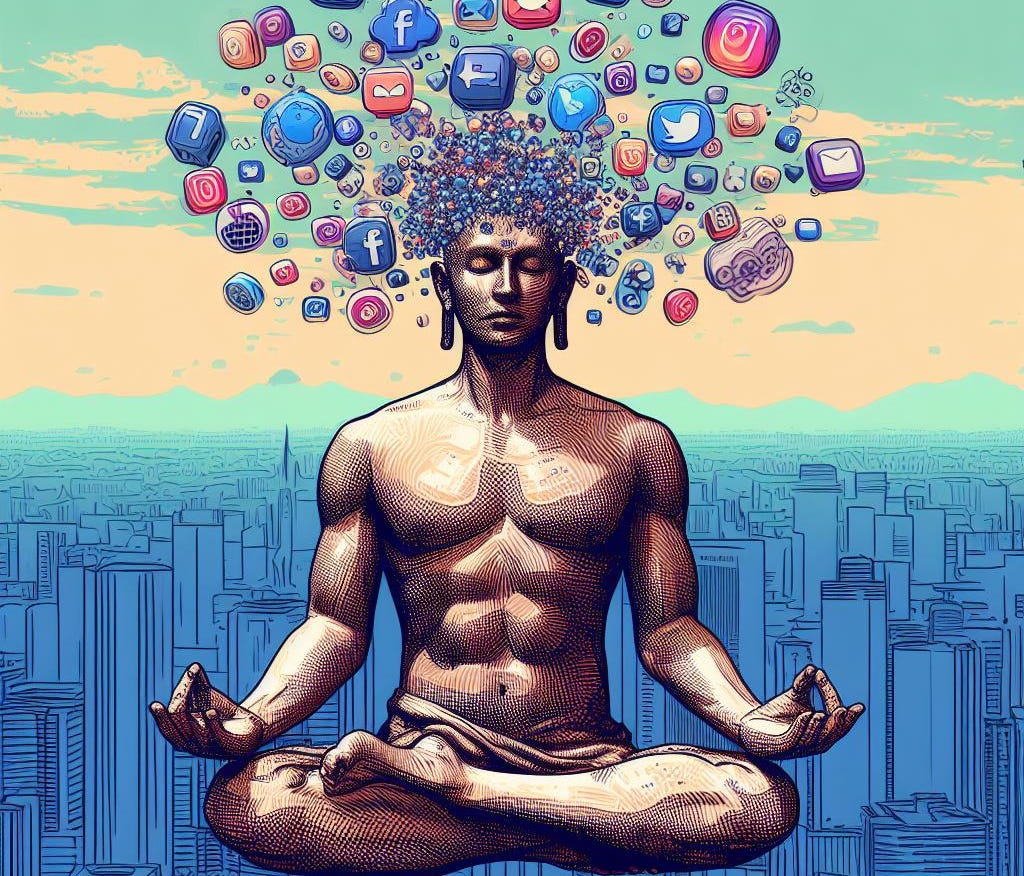The Perceptual Experiment with The Bulimic Scrolling of Instagram.
Contrasting Korean Meditative Music with Social Media Visual Overload.
Recently I conducted a small perceptual experiment: I tried deliberately to listen to the Korean meditative music of geomungo sanjo from my smartphone, while I scrolled in an almost mechanical way the feed of Instagram, lingering on the most captivating and daring photos.
Geomungo Sanjo - Traditional Korean Music
I wanted to observe the effect of the unusual combination of the dilated hypnotic notes of traditional Korean music and the bulimic flow of images on social media. The intent was to stimulate a reflection on the contrast between the spiritual dimension evoked by sonic minimalism and the ephemeral dimension of the visual bulimia of social media.
On one hand the repetitive music of the geomungo sanjo, in its slow and suspended development, transported me into a meditative and internalized dimension, generating a contemplative stillness. On the other, the obsessive scrolling of the feed stimulated anxiety from continuous visual input, an almost frenetic search for novelty.
Causing this perceptual friction was interesting. The juxtaposition between the hypnotic minimalism of Korean meditative music and the bulimic sensationalism of social media highlights the dichotomy between spiritual and material, between transcendent and transient, and between Absolute and phenomenal.
With its repetitive structure and dilated notes, the geomungo sanjo evokes the altered states of consciousness typical of contemplative practice: an inner place of stillness, a timeless dimension in which the ego dissolves and the intuition of the One surfaces. A meditative space is created, a parenthesis in the din of the world, which allows one to transcend the individual self and access ineffable vastness.
Vice versa, the convulsive and bulimic scrolling of Instagram - in search of the most captivating content, the most daring photo - embodies the contemporary addiction to visual stimulation, the incessant need for ever-n newer inputs. The result is a feeling of ephemeral satiety: the images flow without pause, attracted and rejected in an instant.
Thus the opposite poles of existence emerge: infinity and the instant, sacred and profane, eternal and ephemeral. On one side, the music evokes the inexhaustible fullness of the divine; on the other, the constant flow of images evokes the illusion of the phenomenal world.
Is it not true that every human face is a reflection of the Divine Face, which embraces all forms of existence? This is the vision offered to us by the Bhagavad Gita, the sacred song of the Lord, inserted in the great epic poem of the Mahābhārata. In that sublime dialogue, Śrī Kṛṣṇa manifests himself in his universal divine form (viśvarūpa) to his devotee Arjuna, revealing to him the absolute nature of Brahman, the ultimate Reality that too includes.
"I am the Self that resides in the heart of every creature, the beginning, the middle and the end of all beings" declares Kṛṣṇa, the avatar of Visnu, the supreme emanation of the divine on earth (X.20).
Thus Arjuna can contemplate with amazement and trembling the boundless vision (viśvatomukham) of the Lord, which embraces everything in the cosmos: all the worlds, the gods, the divine seeds, the sages and demons; the past, present and future.
"If a thousand suns were to rise in the sky, their light would be similar to that of that Great Being" (XI.12), he exclaims ecstatically Pāṇḍava. All the forms and names, all the multiplicities of the universe dance like threads of light in the infinite luminous ocean (jyotiṃṣi) that emanates from the cosmic body of Kṛṣṇa.
It is the epiphany of Brahman, the One without a second, the Absolute that pervades everything, the transcendent Reality behind the veil of māyā, the great illusion of phenomenal appearance. Like a lightning bolt, Arjuna sees all illusions dissipate and finally understands the supreme teaching of his divine master: Tat Tvam Asi, You are That, the universal Brahman.
Thus, even in the fleeting images that surround us, we can grasp a reflection of the beauty and glory of the Divine Face, which "dances in every atom".
Therefore, in the Advaita perspective, the two planes - spiritual and material - are complementary and interdependent. The transcendent Absolute manifests itself in the immanence of the relative, the ultimate Reality reveals itself through the cosmic play of forms. As stated in the Brihadaranyaka Upanishad, "He is immanent, and at the same time transcendent."
Reflection on the musical juxtaposition ultimately leads to meditating on the mystery of existence, the enigmatic relationship between Reality and appearance. Minimalist music, in its hypnotic repetition, seems to evoke the eternal return, the incessant cosmic pulsation that underlies every natural cycle. Similarly, the flow of images on Instagram refers to the continuous becoming of ephemeral forms.
Both - meditation and the world - refer to the mystery of time and its cyclical and illusory nature. Perhaps the true Reality is beyond time, eternally present. As the mystic Eckhart writes, "The present moment stretched incredibly, became eternity".
In short, it is in the complementarity between these dimensions - spiritual and material, sacred and profane - that we can glimpse the richness and depth of existence. Minimalist music and the visual frenzy of social media are thus revealed as the two inseparable faces of the same, inexplicable, wonderful Reality.
I have woven tales to share, for any who care to read them. My books await you on Google Books. Check also my stories on Medium.com.




